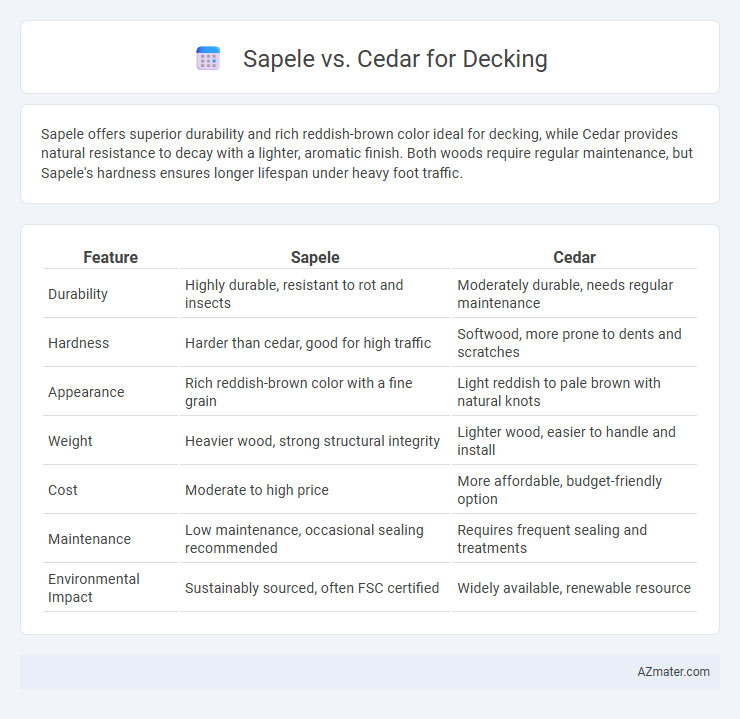Sapele offers superior durability and rich reddish-brown color ideal for decking, while Cedar provides natural resistance to decay with a lighter, aromatic finish. Both woods require regular maintenance, but Sapele's hardness ensures longer lifespan under heavy foot traffic.
Table of Comparison
| Feature | Sapele | Cedar |
|---|---|---|
| Durability | Highly durable, resistant to rot and insects | Moderately durable, needs regular maintenance |
| Hardness | Harder than cedar, good for high traffic | Softwood, more prone to dents and scratches |
| Appearance | Rich reddish-brown color with a fine grain | Light reddish to pale brown with natural knots |
| Weight | Heavier wood, strong structural integrity | Lighter wood, easier to handle and install |
| Cost | Moderate to high price | More affordable, budget-friendly option |
| Maintenance | Low maintenance, occasional sealing recommended | Requires frequent sealing and treatments |
| Environmental Impact | Sustainably sourced, often FSC certified | Widely available, renewable resource |
Introduction: Comparing Sapele and Cedar for Decking
Sapele and cedar are popular hardwood choices for decking, each offering distinct benefits in durability and aesthetics. Sapele is a dense, reddish-brown wood from African mahogany species, known for its strength and resistance to decay, making it ideal for high-traffic outdoor areas. Cedar, prized for its natural oils and aromatic qualities, provides excellent resistance to moisture, insects, and warp, resulting in a lightweight and visually appealing deck surface.
Sapele Wood Overview: Characteristics and Origins
Sapele wood, sourced primarily from West Africa, is renowned for its rich, reddish-brown color and interlocking grain pattern that provides exceptional durability and resistance to rot, making it an excellent choice for decking. This hardwood's natural oil content enhances its resistance to insects and moisture, outperforming many traditional decking materials. With a Janka hardness rating of approximately 1,410 lbf, Sapele offers a balance of strength and aesthetic appeal, rivaling the commonly used Cedar while delivering superior longevity in outdoor environments.
Cedar Wood Overview: Characteristics and Origins
Cedar wood for decking is prized for its natural resistance to decay, insects, and moisture, making it a durable choice for outdoor applications. Originating primarily from Western Red Cedar species native to the Pacific Northwest of North America, this softwood features a distinctive reddish hue and a tight, straight grain that enhances aesthetic appeal. Its lightweight and dimensional stability reduce warping and splitting, providing long-lasting performance with minimal maintenance.
Durability and Lifespan: Sapele vs Cedar
Sapele is a dense hardwood known for its exceptional durability and natural resistance to decay, making it ideal for long-lasting decking with a lifespan often exceeding 25 years when properly maintained. Cedar, while naturally resistant to rot and insect damage, is softer and less dense than Sapele, typically offering a lifespan of around 15-20 years before showing significant wear. When comparing Sapele vs Cedar for decking durability, Sapele provides superior strength and longevity, especially in harsh outdoor environments.
Weather Resistance and Maintenance Requirements
Sapele decking offers excellent weather resistance due to its dense grain and natural oils, making it highly durable against moisture, rot, and insect damage. Cedar, while also naturally resistant to decay and insects, requires more frequent sealing and maintenance to preserve its appearance and prolong its lifespan. Both woods provide solid decking options, but Sapele generally demands less upkeep in harsh weather conditions.
Appearance and Aesthetic Differences
Sapele decking boasts a rich, reddish-brown color with a striking interlocking grain that creates a shimmering, ribbon-like effect, offering a luxurious and exotic appearance. Cedar features a lighter, warm reddish to brown hue with a straight, even grain and occasional knots, providing a more rustic and natural look. Sapele's deeper tones and pronounced figure cater to elegant, high-end deck designs, while cedar's softer colors and grain pattern suit casual, traditional outdoor spaces.
Workability and Installation
Sapele offers excellent workability due to its fine, even grain and moderate density, allowing for smooth cutting and sanding with minimal effort. Cedar is highly favored for installation because it is lightweight and easy to handle, reducing labor time and effort on deck projects. Both woods respond well to fastening and finishing, but Cedar's natural resistance to splitting makes it particularly user-friendly during installation.
Cost Comparison: Sapele vs Cedar Decking
Sapele decking generally costs more than cedar due to its dense hardwood qualities and longer durability, with prices ranging from $7 to $12 per square foot compared to cedar's $5 to $9 per square foot. Cedar is often preferred for budget-conscious projects because it is widely available and easier to work with, leading to lower installation expenses. Despite the higher upfront cost, Sapele offers better resistance to decay and insect damage, potentially reducing long-term maintenance and replacement costs.
Sustainability and Environmental Impact
Sapele offers a sustainable alternative to traditional hardwoods due to its rapid growth and certification under FSC standards, reducing deforestation impact compared to slower-growing Cedar. Cedar's natural resistance to decay and insects minimizes chemical treatments, supporting eco-friendly decking choices with lower environmental toxicity. Choosing Sapele or Cedar for decking aligns with environmentally conscious construction by balancing durability, renewable sourcing, and lower ecological footprints.
Choosing the Right Wood: Sapele or Cedar for Your Deck
Sapele offers a dense, durable hardwood option with rich reddish-brown hues and superior resistance to rot and insect damage, making it ideal for long-lasting decking in varied climates. Cedar is valued for its natural oils that provide excellent decay resistance, lightweight properties, and a warm, aromatic, pale to reddish tone, suitable for decks requiring easier handling and maintenance. Selecting between Sapele and Cedar depends on priorities such as budget, climate exposure, aesthetic preferences, and the desired lifespan of the decking material.

Infographic: Sapele vs Cedar for Decking
 azmater.com
azmater.com